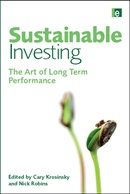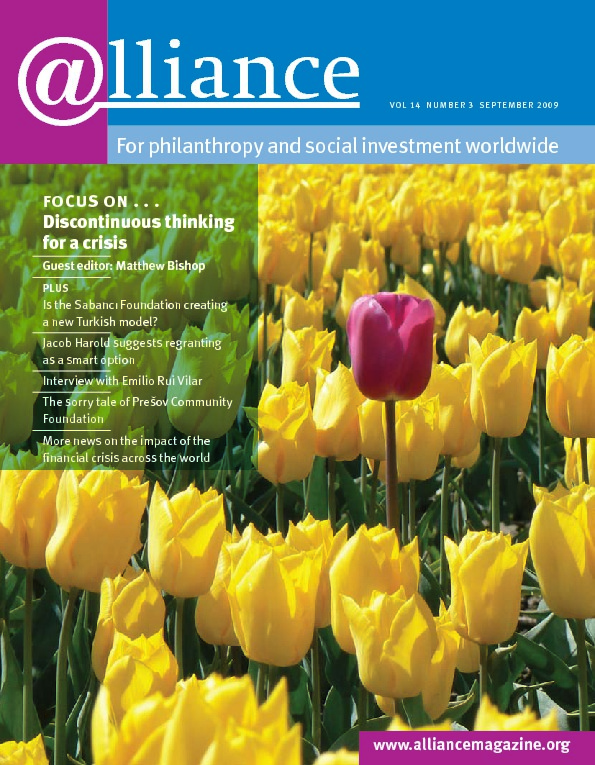Social investing. Ethical investments. Sustainable and responsible investing (SRI). These are a variety of terms in the current financial landscape that all mean similar things: investors who are looking for more meaningful investments. But is it a concept that actually works? Sustainable Investing: The art of long-term performance, a book edited by Cary Krosinsky and Nick Robins, tries to find out.
 The term ‘sustainable investing’ can encompass a number of ethical and social investments. The book attempts to create a definitive glossary of terms for the sector, but given the breadth of the sector, that can be difficult to do. Even in the book itself, some say the term SRI stands for sustainable and responsible investing while others say it means socially responsible investing.
The term ‘sustainable investing’ can encompass a number of ethical and social investments. The book attempts to create a definitive glossary of terms for the sector, but given the breadth of the sector, that can be difficult to do. Even in the book itself, some say the term SRI stands for sustainable and responsible investing while others say it means socially responsible investing.
Co-editor Krosinsky’s view is that sustainable investing can do better than traditional investments, but that this ‘needs to be achieved through diligent, extensive research and careful consideration, and it requires breaking down old patterns of behaviour’.
The seismic shift in the global economy, creating the worst economic crisis since the Great Depression, has obviously changed both the investment landscape and the opportunity for social investments. But part of the problem with the book is that it is outdated. Published in 2008, but likely written in late 2007 or early 2008, it completely misses the stock market implosion of autumn 2008. As a result, it does not offer any insight into how sustainable investing has changed in the past year.
Large institutional investors can be catalysts for change, through the amount of stock they hold in publicly traded companies, but only if they decide to do something about it, Krosinsky says. The American pension funds TIAA-CREF and CalPERS are good examples of activist investing. ‘Without this demand for sustainable investing,’ he says, ‘there exists, in effect, a large, unwittingly passive block of equity ownership, preventing progress towards what could be the most efficient possible corporate behaviour.’
But Julia Fox Gorte, senior vice president for sustainable investing at Pax World Management Corporation, is more optimistic. ‘What differentiates today’s leading corporate sustainability programmes is the integration with corporate strategy, which is why investors are increasingly interested in the links with long-term value creation,’ she writes. ‘Instead of taking an environmental step or inventing a social programme to burnish an image or satisfy a philanthropic impulse, much of what corporations are doing in sustainability today is driven by competition.’
‘The Sustainability Revolution in investment thinking is under way,’ she adds. ‘The only question is whether it can grow fast enough to avoid the unmanageable consequences of unsustainable operations.’
However, to support the burgeoning sustainable investing universe, financial analysis must be able to address the costs of sustainability issues, such as environmental provisions, costs associated with complying with regulation and other matters, write Valery Lucas-Leclin and Sarbjit Nahal, co-heads of SRI Research at Société Générale. ‘One could say that accounting is concerned with the past, while financial analysis attempts to predict the future. Sustainability analysis, if it is to survive and prosper, must do the same,’ they write.
The SRI Research department at Société Générale employs its own analytic system. Lucas-Leclin and Nahal believe that the bottom line, a company’s valuation, can be affected by environmental, social and governance (ESG) factors.
What the book does not address is the need for more pension funds, charitable foundations and asset managers to become more active in social, ethical and sustainable investing, including SRI funds, but more importantly mission-driven investments and investing in global funds with a social mission. Without more capital moving into this investment universe, it will always remain on the periphery, and its influence will be limited.
While sustainable investing has made much progress since the early days of activist investors who used annual general meetings in the 1970s to publicly embarrass companies with operations in South Africa, much more work needs to be done. When impact is as important as risk and return to mainstream investors, the influence of sustainable investing will truly be felt.
Investors’ perspectives is produced in collaboration with Investing for Good, a social finance intermediary and asset manager founded in 2004.
http://www.investingforgood.co.uk
Maureen Stapleton is an analyst at Investing for Good in London. Email mstapleton@investingforgood.co.uk
Sustainable Investing: The art of long-term performance
Cary Krosinsky and Nick Robins (eds)
Earthscan
£19.99
ISBN 9781844075485
To order
http://www.earthscan.co.uk
Also of interest
Articles by Peter Blom, Reuben Abraham and Alvaro Rodriguez on the new opportunities for social investment.


Comments (0)